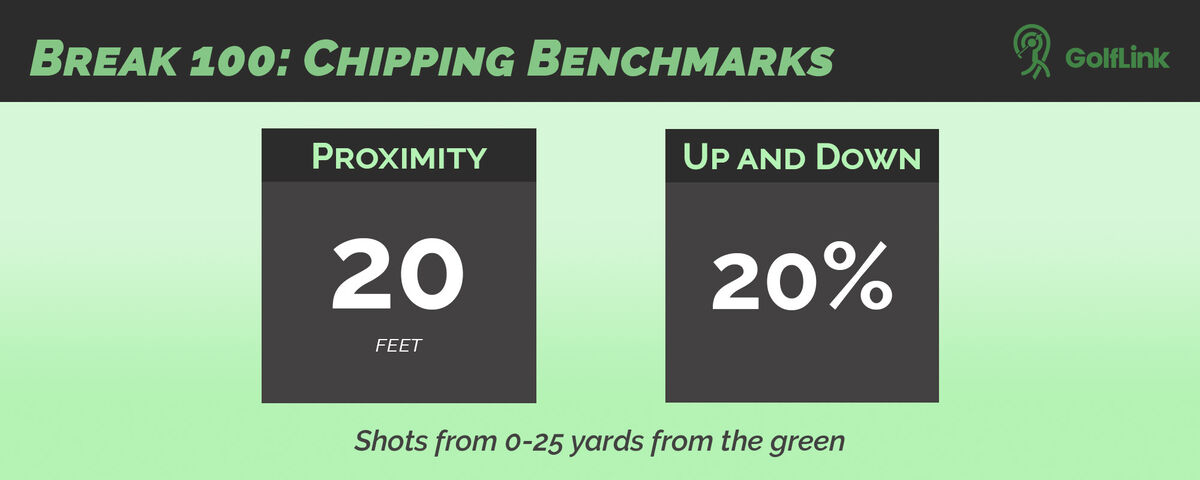How To Break 100 Lesson 3: Chipping

Once you can start getting up and down – that is, chipping your ball onto the green and making the putt – your scoring potential really takes off. In this lesson, we’ll assign you some chipping benchmarks, teach you the simple chipping stroke, and give you a great drill that will sharpen your short game faster than you thought possible.
RELATED: How To Break 100 Course Overview
Breaking 100: Chipping Benchmarks

We’ve identified two chipping benchmarks that can help you determine if your short game is sharp enough to break 100, or if it could be the piece that’s holding you back.
On shots from off the green but within 25 yards of the hole, keep track of your proximity to the hole, and whether or not you get up and down successfully. Your target proximity is an average of 20 feet to the hole, and your target up-and-down percentage is 20%, or one out of five times. These are roughly the stats of a 20-handicap golfer, or someone who typically shoots scores in the mid to low 90s, so if you can consistently make these marks, you know your short game has you poised to shoot your goal score.
|
Stat |
Target |
|
Proximity (From 25 yards and in) |
20 feet |
|
Up and Down Percentage (From 25 yards and in) |
20% |
PREVIOUS LESSON: How To Break 100 Lesson 2: Putting
Proper Chipping Technique
Allow Hank Haney, one of the greatest golf teachers of this generation, most famous for serving as Tiger Woods’ instructor during Tiger’s prime, to teach you how to chip.
The chip shot is one of the simplest shots in golf. To set up for a chip shot, put the ball back in your stance and keep your hands ahead (closer to the target) of the club head, with most of your weight on your front leg. Open your stance slightly by moving your front foot back a few inches. This allows your arms the freedom to swing the club back and through without your body getting in the way.
From this setup position, make a short, firm stroke with no wrist action. Try to match the length of your backswing with the length of your follow-through to make sure you accelerate through impact. Hit the ball slightly on the downstroke for crisp, repeatable contact, with your hands ahead of the ball at impact. Fly the ball a short distance and let it roll to the hole.
5 Ball Drill to Master Your Chipping
Once you’re comfortable with your chipping technique, there’s no better drill to put it to the test than Mike McGetrick’s Five Ball Drill. This drill will give you a great indication of how your chipping compares to your Breaking 100 Benchmarks.
- Pick a hole on the practice green and a starting spot a few yards off the green
- Chip five balls from that starting spot to the target hole
- Your objective is to get three balls to finish within one club length of the hole
- If you make one, it counts as two
Once you chip three out of five to within a club-length of the hole, pick a different hole and staring point, and keep practicing. When you can consistently pass this test, ratchet up the pressure by moving the target score to four out of five, then five out of five.
When you can consistently chip three out of five to within a club length in practice, you should have no problem hitting your benchmarks of getting up and down 20% of the time and chipping to within 20 feet from within 25 yards when the pressure’s on.
Conclusion
Having confidence in your chipping ability is an absolute game-changer, especially for golfers on the cusp of breaking 100. According to data from Arccos Golf, the average 3-handicap player misses half of their greens in regulation, and the average 20-handicapper misses the green 80 percent of the time. This is proof that a strong short game is not only key to breaking 100, but you’ll rely on it no matter how good you become. Dedicate some serious time to this chipping lesson and you’ll see the benefits in your scoring.
NEXT LESSON: How To Break 100 Lesson 4: Pitching